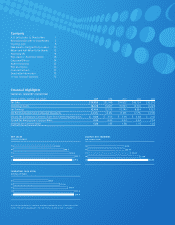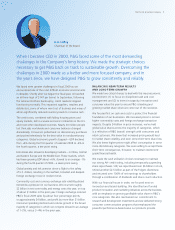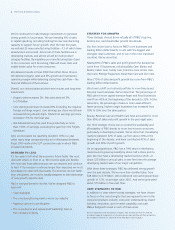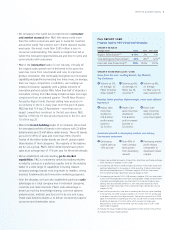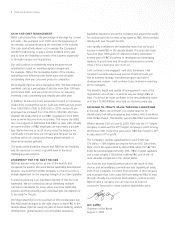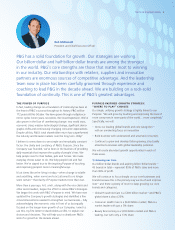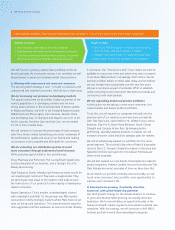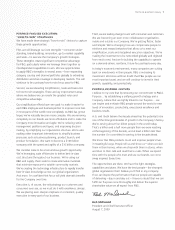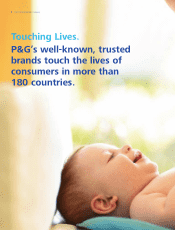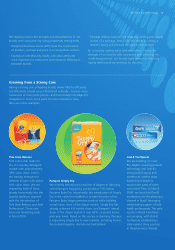Proctor and Gamble 2009 Annual Report Download - page 3
Download and view the complete annual report
Please find page 3 of the 2009 Proctor and Gamble annual report below. You can navigate through the pages in the report by either clicking on the pages listed below, or by using the keyword search tool below to find specific information within the annual report.
We faced even greater challenges in fiscal 2009 as we
encountered one of the most difficult economic environments
in decades. Shortly after we began the fiscal year, oil reached
an all-time high of $147 per barrel. In September, following
the Lehman Brothers bankruptcy, credit markets stopped
functioning normally. This impacted suppliers, retailers and
distributors, some of whom went out of business and many of
whom significantly reduced inventory levels to conserve cash.
The credit crisis, combined with falling housing prices and
equity markets, led to a severe economic contraction in the U.S.
and most other developed countries. Nearly 30million people
lost their jobs worldwide and consumer behavior changed
dramatically. Consumers pulled back on discretionary purchases
and pushed relentlessly for the best value in nondiscretionary
categories. Global economic growth stopped
—
GDP declined
from +4% during the first quarter of calendar 2008 to -6% in
the fourth quarter, a ten-point swing.
Economies also slowed in developing markets
—
in China, Central
and Eastern Europe and the Middle East. These markets, which
had been growing GDP about +6%, slowed to an average -1%
during the fourth quarter of 2008
—
a seven-point swing.
Global anxiety and risk aversion drove a flight to the safety
of U.S. dollars, resulting in the swiftest, broadest and deepest
foreign exchange move in modern times.
Commodity cost and currency exchange rate volatility placed
tremendous pressure on our business. We incurred roughly
$2billion in net commodity and energy costs this year, on top
of about $1billion in the prior year. Foreign exchange reduced
P&G’s fiscal 2009 sales by about four percentage points,
or approximately $4billion, and profit by more than $1billion.
Consumer spending declined and volume growth in the broad
majority of categories in which we compete slowed to an average
of 1–2%, versus 3–4% in the prior year.
BALANCING NEAR-TERM RESULTS
AND LONG-TERM GROWTH
We made two critical choices to deal with this macroeconomic
environment: (1) to focus on disciplined cash and cost
management and (2) to invest in capacity, innovation and
consumer value this year to ensure P&G is leading and
growing market share when we come out of the recession.
We focused first on cash and costs to protect the financial
foundation of our businesses. We increased prices to recover
higher commodity costs and foreign exchange transaction
impacts. Despite $4billion in price increases, we’ve held
global value shares across the majority of categories, which
is a reflection of P&G brands’ strength with consumers and
retail customers. We knew that increased pricing would lead
to market share volatility, and even some short-term share loss.
We also knew higher prices might affect consumption in some
more-discretionary categories. We were willing to accept these
short-term consequences, however, to maintain investment-
grade financial health.
We made the cash utilization choices necessary to maintain
our strong AA- credit rating, including temporarily suspending
share repurchases. Still, we repurchased over $6billion in stock,
retired another $2.5billion as part of the Folgers divestiture,
and returned over 100% of net earnings to shareholders
through a combination of dividends and share count reduction.
With our financial house in order, we focused next on
innovation and brand-building. We identified and funded
product innovation and marketing initiatives across the business,
with an emphasis on growing profitable value share in P&G’s
core categories. We also maintained our commitment to
research and development investments and we delivered strong
consumer communication programs that emphasized the
powerful performance-based value our products provide.
When I became CEO in 2000, P&G faced some of the most demanding
challenges in the Company’s long history. We made the strategic choices
necessary to get P&G back on track to sustainable growth. Overcoming the
challenges in 2000 made us a better and more focused company, and in
the years since, we have designed P&G to grow consistently and reliably.
A.G. Lafley
Chairman of the Board
The Procter & Gamble Company 1


